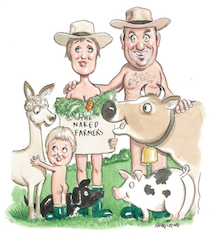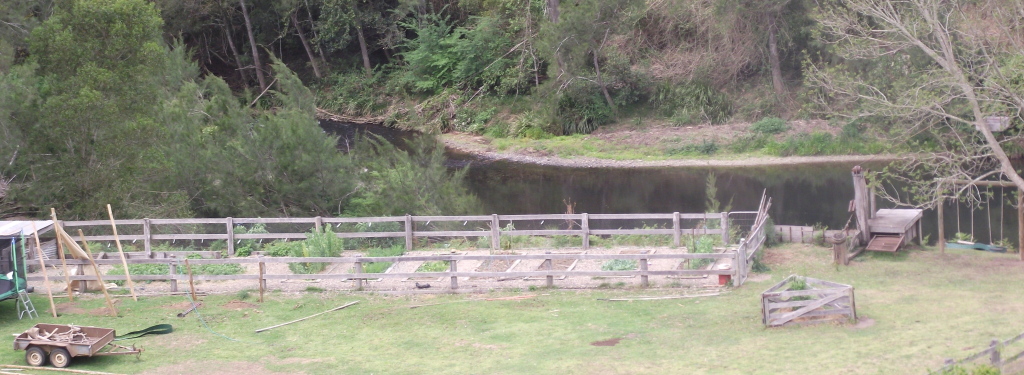So many of us are trapped in our poverty consciousness – strapped to the relentless wheel of working for the man, paying off our loans, credit cards and mortgage, and never seeming to make headway in our consumer culture. We have lost sight of where our food comes from, don’t know how to get our hands dirty, or experience the satisfaction that comes from a hard day’s labour done (or feel the pain of a back which has worked hard!) And yet, the hardest part of growing your own food is deciding where to designate as veggie patch, fencing it from predators (when it comes to the veggie patch, chooks, wallabies, rabbits and birds are all predators!) and building the raised beds or digging over the dirt initially.
Once all that is done, the rest is not so hard and really needs just a few hours of dedication once a week and daily forays to pick, squeeze, marvel and wonder at. Oh, and, deep watering once a week if the sky is not complying with sufficient heaven sent. Weeding steals the most time so careful thought and research as to the best way to discourage them from daring to venture into your patch is time well spent at the outset. The first principle of organic gardening is to cover the soil, so I think copious amounts of straw and newspaper really are the best bet. Finally, all those piles of used and unused paper, can be recycled in an intelligent way, without resorting to council waste services, or plastic weed mat.
Ged is very good at doing the deep digging to save my back but when he’s not around I enjoy it – it’s very satisfying watching the soil get richer and more chocolatey, flaking off the fork like a good, crumbly cake. Of course, we have no shortage of poo here but it has taken me 3 years to learn that it’s quality, not quantity, that counts. While all the horse and cow poo has undoubtedly enriched the soil, it has also imported grass seeds which means more weeding! Alpaca poo – now there is a wonderful, magical, pellet to enrich the soil and create black velvet . . . and no weeds (don’t ask me how they do it!)
I have bought plenty of plants from Bunnings and other nurseries over the years and many, if not most, have died. Certainly the fruiting plants have soon turned up their toes. But then I discovered Diggers and Heritage Fruit Trees and now I have wonderfully healthy plants. Last year was my first year buying from Heritage Fruit Trees and within weeks of putting in their blueberry and raspberry plants we had fruit and Ben spent all summer finding and eating their generous output. Want to get a small child interested in fruit and veggies? Plant a patch and watch them eat peas, broccoli, spinach, blueberries, raspberries, strawberries and even garlic chives and nasturtium flowers, fresh from the garden! Ben has become so used to being able to eat plants that our problem is getting him to check first whether he can eat something either in the garden or the wild! His eagle eyes are the keen spotter of wild raspberry plants in every crevice of the farm and we have to go on wild raspberrying forays all through winter – yum!
I love the fact that Diggers are working with Seed Savers in the US to share and keep heirloom and heritage seed varieties. Now that the evil Monsanto (manufacturers of Round Up and Round Up resistant GM crops – did you know that GM crops are sprayed with Round Up to kill weeds but the crops grow regardless, absorbing all those lethal chemicals into their cellular structures?) have taken over Yates seeds and are on a mission to buy all seed producers and purveyors, we owe it to our children and the future of the planet to be very very careful where we get our seeds from. After all, there is no life without seeds and a world where one monolithic chemical company owns all the seeds is seriously scary.
When I first heard of planting by the moon I thought it was very woo woo but now it is second nature. Weeding with the waning moon, planting on the full. Plants and seeds needing to grow downwards (carrots and parsnips or plants needing to send down strong roots) go in on the waning moon and seeds and plants to reach up to the sky go in on the growing (waxing) moon. Planting by the moon was developed as part of Rudolf Steiner’s system of BioDynamic Farming, but has now become a widespread and commonly understood method of planting and harnessing nature’s forces. The more I know about Steiner the more I respect him – he was a man well before his time.
I have been known, midsummer, in the cooler midnight hours to be out in the veggie patch, stark bollock naked, preparing the ground and planting seeds under the bright silver light of the full moon in all her resplendent glory. But really you would need to be a gardener to understand that!
Put in the seeds, water them, and watch them grow. Now that the earth and sun are warm it is amazing how quickly little seeds (and some of them are very little!) turn into little plants reaching up to the light. With the current dry it looks like we are going to be spending a lot of time watering, but I find holding the hose in one hand, and weeding with the other is quite a satisfying way of tending my patch (multi-tasking as ever!) I have spent years neglecting the patch from one week to the next and then being overwhelmed by the weeds so I think little and often is a better way forward. I am still such a beginner veggie patcher, and learning all the time. At the moment my favourite relaxing bedtime reading is a bit of Peter Cundall – I find him very reassuring!
What I do know, is that those few packets of seeds (and it is worth buying good organic seed) yield an incredible abundance for the kitchen, our bellies and the freezer. At times that abundance can be overwhelming, and finding creative ways to deal with a glut stretches the imagination, the powers of good old google, and the forbearance of the family at mealtimes. But that’s Mother Nature – so generous, so richly abundant, nurturing and fulfilling. Never an empty plate, never any excuse not to create something healthy and nutritious and fresher than fresh to feed both our bellies and our spirits – true soul food – sewn, nurtured and reaped in bountiful harvest by our own two hands. It doesn’t get much better than that. And as we experience this rich bounty, and the over abundance we are given, we realise that there IS enough, there is always more, that we are enough and are good enough to experience the best life has to offer. We learn to nurture ourselves as well as others. To feed ourselves with love. That each has its time and its season (all the old truisms are true!), that we need time to grow, that death and decay are essential and feed the soil, that the circles, cycles and rhythms are endless (sometimes relentless . . . ) and the world and her mysteries will still be here turning, revolving, evolving long after we are gone.
We reconnect with our primal natures. With man at his most basic – feeding the land, sowing the seed, reaping the harvest, loading the table and giving thanks, grateful thanks for the bodies and minds and hearts to enjoy it. And even when the earth seems dead and dormant, there are seeds and bulbs underground lying, waiting to burst forth in the warmth of spring. And we realise that every age, every part of life is beautiful. We lose our dependence on and despairing hankering for the blossom of youth and we learn to relish our own process and ageing and acquired wisdom. And as we reconnect with the earth so we realise that we will return to it one day and that is ok. We can feed a tree, provide shade and shelter, look pretty eternally and leave a legacy, however insignificant, as one who loved and tended and learned from the land.
Self sufficiency can be hard work, but it is so satisfying and to know where your food comes from – literally from paddock to plate is such a good feeling. I hate how removed from our food and its sources we have become. How the sterile aisles of Coles and Woolworths with their glaring lights, dyes, sprays and additives entice us to part with our hard earned for things that we literally wouldn’t feed to the pigs here.
And yet we can all grow a little ourselves and learn to reconnect with nature, with food, with what fresh food REALLY tastes like (grow tomatoes and you will never buy another tomato again!) In a tub, in a pot, on the verge, in a little plot at the end of the garden, we can all start small and grow fresh, chemical free, real food. And something magical happens when we grow things – we reconnect with our source, with spirit, with light and rain and the seasons. With the moon, with the earth, with its creatures great and small. We dig our hands deep into the soil, get dirt under our fingernails and get real, real fast.
Ditch the plastic fantastic and the greed of the gimme, gimme, gimme, instant gratification of the relentless consumer society and cultivate a little patch of dirt. Chuck in some seed, enjoy a daily sprinkle session and wait . . . I promise you won’t be disappointed. But I warn you – it’s highly addictive, this gardening malarkey. My Mother sent me a postcard once which said there were 3 phases of the female life – horses, hormones and horticulture. My poor neglected horses are testimony to the fact that horticulture has bitten me hard.

